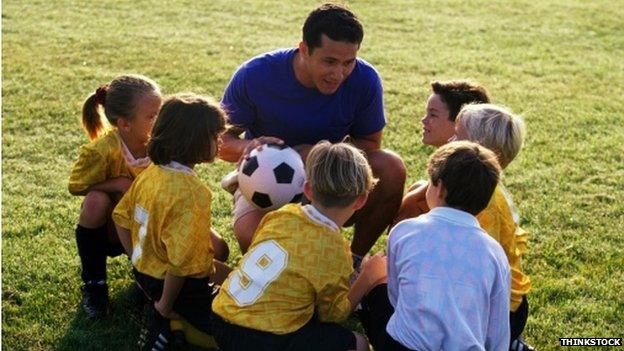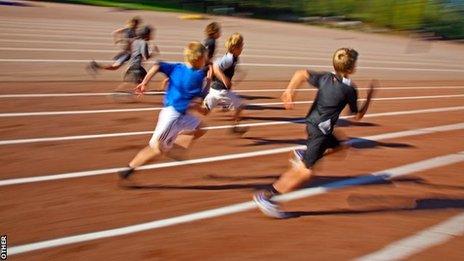Extra PE cash is having positive effect, say ministers
- Published

From last September primary schools in England have received extra cash for PE and sport
Children in nine out of 10 primary schools in England are getting better PE lessons thanks to new sport funding, suggests research for the government.
Researchers asked more than 500 schools how they were spending the government's £150m-a-year PE and Sport Premium.
Education Secretary Nicky Morgan said she was delighted the money was "having a positive effect".
The Sport and Recreation Alliance said it was a "shot in the arm" after other PE funding cuts under the coalition.
The PE and Sport Premium was introduced a year ago. The money, worth more than £9,000 a year to a 250 pupil primary school, goes directly to headteachers.
New equipment
Its introduction followed complaints the government had "turned its back on on school sport" and undermined the Olympic legacy following London 2012.
In 2010, £162m of ring-fenced funding for the national School Sport Partnerships (SSPs) was abolished, provoking an outcry. The network enabled well-equipped "hub" secondary schools to lend PE teachers to those that needed them, especially primary schools.
Ministers say the Premium, which will continue until 2020, is enough to pay for a PE teacher two days a week.
The government commissioned NatCen Social Research to find out how primary schools had spent the money.
Interviews carried out in primary schools between April and July this year found
Three-quarters had used the money on new equipment or to provide after-school sports clubs
A fifth said they had made after-school club sports completely free
84% said the money had helped them boost pupils' engagement with PE during lessons
83% said more pupils were attending after-school sports clubs.
91% reported an improvement in the quality of PE teaching, with the remainder saying it had stayed the same
96% said pupils were fitter and healthier
93% saw better behaviour among pupils
63% said they had increased the number of competitive sport fixtures against other schools
The researchers found that the proportion of schools using specialist PE teachers rose from about a fifth (22%), to over half (54%).
The improvements were most marked in schools with a high proportion of free school meals.
Over half of schools with more than a quarter of pupils on free school meals said the money had helped them improve sporting facilities - compared with 39% of schools with the lowest levels of pupils receiving free meals.
The education secretary was joined by 2012 Olympic cycling gold medallist Victoria Pendleton for the launch of the report.
Ms Pendleton said she hoped the money would make a difference to primary school sport.
Sporting benefits
"Whether it's a netball tournament between a few local schools or being part of an after-school football club, competitive sport really helps children learn resilience, team work, and builds character - not to mention the clear benefits for their health," she said.
"Sport at school shouldn't be sidelined."
James Allen, head of policy at the Sport and Recreation Alliance, which represents sport governing bodies, said: "The funding is bound to be a shot in the arm for schools following the demise of School Sport Partnerships.
"Many schools are making excellent use of the extra funding.
"What we would like to see now is consistent and robust inspections from Ofsted to make sure that every school is getting its physical education offering right."
Wasim Khan, chief executive of the schools' cricket charity Chance to Shine, said: "While we welcome today's findings and the news that more young people are reaping the benefits of competitive sport, we would urge schools to choose carefully quality sports providers to ensure their pupils are getting the best possible sporting experience."
Baroness Sue Campbell, chairwoman of the Youth Sport Trust called the figures "extremely encouraging" and advised schools to spend the money on PE focused professional development for existing staff as this would continue to pay off even once the funding ended.
"For those schools that are using this funding to hire in services through external providers within school hours I would urge them to consider how this will continue to benefit them in two, three or four years time."
- Published6 February 2014

- Attribution
- Published15 March 2013

- Attribution
- Published15 March 2013
- Published15 December 2012
